Part 2/5: Rebuilding Puerto Rico’s Battered Farms
Published: September 21, 2019
By Bobby Bascomb
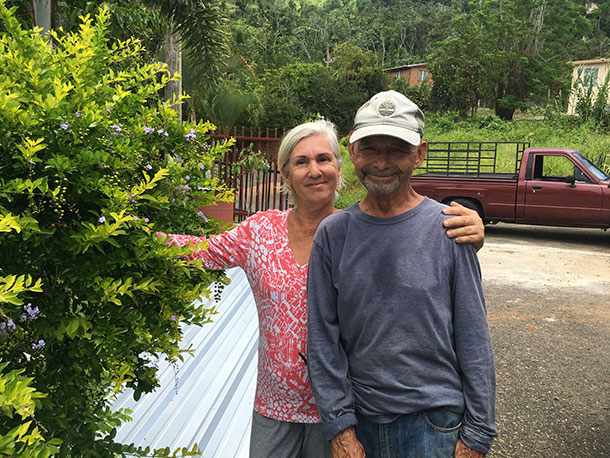
Farmers Domingo and Nilsa Romano are grateful for the physical and emotional support of the volunteers with the NGO El Departamento de la Comida. (Photo: Bobby Bascomb)
(stream/download) as an MP3 file
Even before Hurricane Maria, Puerto Rico imported nearly all of its food, and the powerful storm left many Puerto Ricans with no choice but to skip meals and live on canned food for months. But volunteers and farmers are working together to rebuild Puerto Rico’s small and devastated farming sector.
BASCOMB: Alright, hey, Adnelly. How's it going?
MARICHAL: I'm doing well. How are you?
BASCOMB: Good, good. So this time, we're going to talk about the story that I actually met you through. It's about farming in Puerto Rico.
MARICHAL: Yeah, definitely something I've been involved with for the last year.
BASCOMB: Yeah. Is that why you moved back to Puerto Rico to work on farming?
MARICHAL: Well, originally, I wanted to work on a documentary project about medicinal plants and their history and their use here in Puerto Rico, based on the work of a really well known herbalist here in Puerto Rico named Maria Venditti. So that was my original project. But of course, everything got put on pause after the storm. And I still knew that I wanted to document something around plants and agriculture. But I also knew that I wanted to help in whatever way I could with aftermath of the storm. And luckily, in early January, I was introduced to a group that was doing exactly that. They were collecting seeds from all over the country and distribute them to farmers. And they were taking a bus all over the island to help small ecologically based farms. So I started working with them as their documentarian and got to see just how amazing of a community there is here of ecological farmers.
BASCOMB: You actually made a documentary about really growing farms after the storm?
MARICHAL: I made a series of short videos, yeah, about that project and about some of the farms that we visited. And that project is ongoing. And I am continuing to work with farms here in whatever way I can to help even just volunteering my time, not necessarily my, my documentary work, just because I love being outside. And it's just a really great community. Everyone I've met over the course of the last nine months is incredibly welcoming. And it's a great community.
BASCOMB: Yeah, I definitely got that sense. So that's where we're going in this story is about rebuilding farms and just how devastating it was for the agricultural sector after the hurricane.
MARICHAL: Definitely.
BASCOMB: Yeah, it was really surprising to me, actually, I learned a lot in doing this story just about how dependent Puerto Ricans are for food to come from off the island. I mean, it's a tropical island, you get loads of sunshine and rain, and yet you import almost all of the food.
MARICHAL: Yeah, we import before the storm. It was about 85%. And after the storm, it was 95% at least of food was imported here, which is a pretty staggering number.
BASCOMB: Yeah, definitely. Alright, well, let's go ahead and listen to this one.
[MARKET SOUNDS]
BASCOMB: Nine months after the storm one of the only places to find locally grown food on the island is farmer’s markets like the Saturday market in Rincon on Puerto Rico’s west coast.
MAN: Do you have kale?
CARLO: Yes, we have kale. You want baby kale or dinosaur kale?
MAN: Dinosaur kale? How’s that?
BASCOMB: Sonia Carlo’s nearby farm is slowly recovering from the storm. Today she’s brought pineapple, papaya, mushrooms, and the kale she’s explaining to a customer.
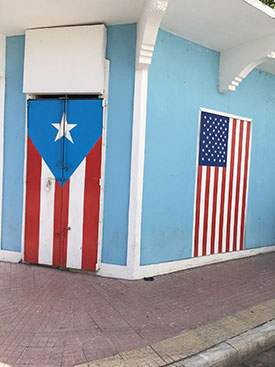
The Puerto Rican and American flags painted on the corner of a building in Rincon, Puerto Rico. The Puerto Rican dependence on imported food can be attributed, in part, to US economic incentives. (Photo: Bobby Bascomb)
CARLO: …. They’re two for five, so if you want both of them…
MAN: I like kale. What’s a single go for?
CARLO: Three, or two for five.
MAN: You got change?
CARLO: Yeah.
MAN: I’ll take…I’ll take both. Why not?
CARLO: Alright. One and one? Thank you.
BASCOMB: Sonia’s bright smile makes her a natural salesperson.
CARLO: It's a good time to be at the market right now.
BASCOMB: Sonia says things are just starting to turn around for her family and the farm. They are finally harvesting again and her farm to table restaurant, Sana, opened just a few weeks ago. But Hurricane Maria was devastating for them. The storm destroyed her home. She had to send her 3 children to Florida to live with family while she and her husband, living in their car, rebuilt the battered farm.
CARLO: We got really trashed. All of our production for years of tropical trees like mango trees and passionfruit trees, they all died and they all were blown away. We had trees that were a hundred years old and you know, totally perished. Since the hurricane was a cyclone, it brought some salt water and some sand with it, so everything that was in its path, it looks like you threw herbicide.
BASCOMB: Across the island tall fruit trees were the most heavily damaged food crop. Root vegetables that could hide underground did ok. Ground plants like pineapples were among the first to recover, and fast growing vegetables like salad greens were easy enough. After the hurricane, visitors came to Puerto Rico with their suitcases full of seeds to donate to farmers. Sonia says they actually could have started growing again relatively quickly.
CARLO: But since we didn't have any electricity, we couldn't pump water out and we didn't have any gas, so we were unable to grow food because we don't have gas to pull out the water from the water pump. You know, it was just - you know trying to scrape up anything. Waiting ten hours for gas, just to grow food. It was very uncertain.
[SFX LATIN MUSIC IN GROCERY STORE]
BASCOMB: Grocery stores are open again on the island. But visit a grocery store on Puerto Rico and you’ll be hard pressed to find anything supplied by local farmers. I went shopping at an Amigo chain grocery store, which is owned by Walmart.
[SFX GROCERY STORE SOUNDS]
BASCOMB: Let’s see, there’s pineapple from Costa Rica, coconuts from the Dominican Republic. Honeydew melon from Guatemala. Over here there’s more watermelon, chopped up – [gasp]. Aha! I found some watermelon from Puerto Rico. These are watermelon already cut up into pieces. The whole watermelon came from someplace else.
[GROCERY SOUNDS]
BASCOMB: To understand why this lush tropical island with year round sunshine and rain imports nearly all of its food, you need to go back to the 1940s and a US initiative called Operation Bootstrap.
MARICHAL: With the colonization of the US there was a movement to get people out of their farms and into the cities.
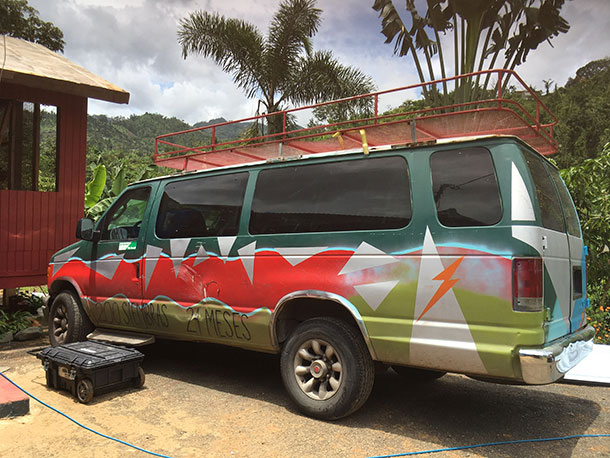
El Departamento de la Comida volunteers travel to farms in a bus, locally known as a guagua, which carries all the equipment they will need for their work. (Photo: Bobby Bascomb)
BASCOMB: Adnelly Marichal is the documentarian for the Resilience Fund in Puerto Rico. She says Operation Bootstrap transformed Puerto Rico from a largely agrarian economy to one based on manufacturing and tourism. They did that with a patchwork of government tax incentives and access to US markets. The farming that remained was not on the household level but on a larger, industrial scale.
MARICHAL: Now suddenly, it’s about making money so therefore you need to grow things like sugar and coffee. And that’s great, but those are not things that people can eat.
BASCOMB: And the food that is imported to Puerto Rico is on average 20% more expensive than in the US. That can be attributed at least in part to the Jones Act of 1920, which says any item imported to Puerto Rico must be carried on a US vessel. So, if Puerto Rico wants to import let’s say tomatoes from its neighbor, the Dominican Republic, those tomatoes must first go to the US mainland more than 800 miles away. They get put on a US boat, and then travel back those same 800 plus miles to Puerto Rico.
MARICHAL: So, it both makes the food more expensive and less nutritious by the time it gets here; it’s been on a boat much longer than it has to be. It just creates a much longer timeline.
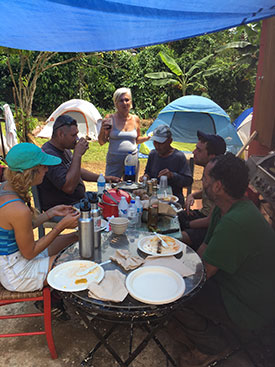
Volunteers eating lunch before they get back to work fixing the Romano’s roof. (Photo: Bobby Bascomb)
BASCOMB: One of the few agricultural areas of Puerto Rico is called Las Marias. The region is known for growing oranges for orange juice. I drove to Las Marias to meet with a small scale orange farmer.
[DRIVING SOUNDS]
Las Marias is way up in the mountains on the western half of the island. My drive is 13 miles but it took more than an hour on narrow, twisty, nausea-inducing mountain roads. My GPS signal failed and I got wildly lost. It’s difficult to get here on a good day. After the hurricane it was impossible. Las Marias was cut off from the rest of the island for 2 months and had to have supplies airlifted in by helicopter.
[CHICKEN SOUNDS]
BASCOMB: Farmer Domingo Antonio Romano is 75 years old and has a small farm here with his wife, Nilsa. He walks past his chicken coop and stops in front of his only orange tree that survived the hurricane.
ROMANO: Only one, tenemos una sola.
BASCOMB: He used to have 20. Before the hurricane most of Domingo’s farm was made up of coffee, mango, and orange trees. The very crops most impacted by the storm.
ROMANO: (SPANISH) 90% of our farm was destroyed but it was really like 100% because with the hurricane no one could come here to harvest.
BASCOMB: Near the one surviving orange tree, amid debris of tree limbs and weeds, is a small patch of vining plants.
ROMANO: (SPANISH) This is a purple yam, they are very good.
BASCOMB: Root vegetables like yams were really the only food crops that didn’t get torn away by the 155 mile an hour winds of hurricane Maria. They were one of the only food crops the Romanos could still harvest and eat after the storm. But animals in the area were also struggling to find food. Wild pigs quickly discovered the purple yams and ate most of them.
ROMANO: (ENGLISH) Before Maria, we have many. But we have nothing.
BASCOMB: Domingo and his neighbors still had months to go before the roads would be cleared or the electricity restored. He says in that time they came to rely on each other for help.
ROMANO: (SPANISH) Before Maria, there was forest everywhere. And then, after Maria, the trees came down and we could see our neighbors and we got to know each other. After the hurricane, there was a lot of empathy between the people, and everybody helped each other. And the bees! We got to feed them. After the hurricane there were no flowers so we put out sugar water for them.
BASCOMB: His crops were destroyed and the roof torn off his house. They were without running water or electricity for months. Domingo says it would have been impossible for him to rebuild alone. But he’s not alone.
[CONSTRUCTION SOUNDS]
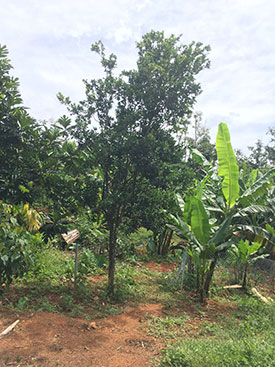
The Romano’s one remaining orange tree. (Photo: Bobby Bascomb)
BASCOMB: 5 volunteers from a grassroots non-profit group called El Departamento de la Comida, the Food Department, are here to camp out on the farm for a week and do any work that needs to be done: clear land, plant crops, fix fences and repair the roof.
[CONSTRUCTION SOUNDS]
BASCOMB: The volunteer Food Department is organized into groups called brigades and are dispatched all over the island. As many as 20 people at a time descend on a farm for a week, bringing with them seeds, tools, building supplies, and the man power to get a farm back up and running. Edan Freytes is the leader of this brigade. He says they do this work because farmers are crucial for Puerto Rico going forward.
FREYTES: The farmer is the… the agriculture is like the espina.
BASCOMB: The backbone.
FREYTES: The backbone of the country. And it’s the most damaged sector. I think it’s the sector we need more to help, because it got the worse loss.
[COOKING SOUNDS]
BASCOMB: Farmer Domingo’s wife, Nilsa, is in the kitchen cooking lunch for the volunteers… cassava root, sliced tomatoes, rice and beans. She lifts the top off a pot of soup she’s been working on since this morning.
N. ROMANO: (SPANISH) This has pork, bread fruit, green banana, onion, pepper, cilantro, and garlic.
BASCOMB: Nilsa says she’s happy to have the volunteers here. The work they are doing in a week would have taken her and her husband months. But beyond the physical help she is grateful for the emotional support and encouragement the volunteers bring.
N. DOMINGO: (SPANISH) It’s very emotional for me because I was very depressed. It was a very traumatic experience. For months we were without water, electricity and a roof. And we were alone. With this group here I’m just so grateful for the support. So grateful.
BASCOMB: The volunteer Food Department has set a goal to send brigades like this to 200 farms across Puerto Rico, large and small, organic and commercial. They simply want to support domestic agriculture in any form.
[MARKET SOUNDS]
BASCOMB: Sonia Carlo from the Rincon Farmer’s market says she had similar support, not from an organized group but from friends, neighbors, and strangers volunteering their time to help her rebuild.
CARLO: What really got us through everything was the community. This, you know, we had a commitment to our community, especially in Rincon, people just said “what do you need, I’ll help you. What do you need, you need hands?” And we said “yeah, we need people.” “I’ll help you”. You know, and that gave us strength to keep growing and producing.
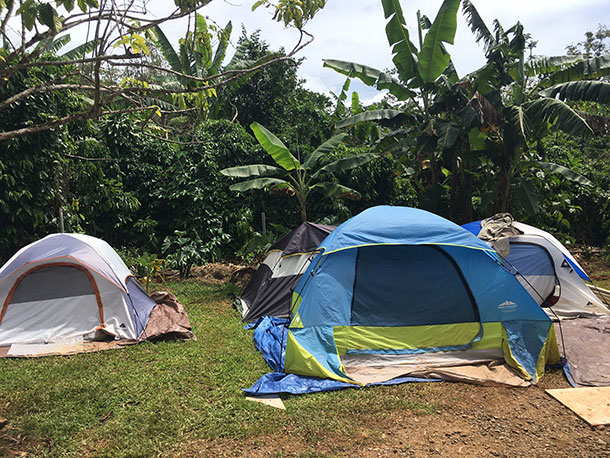
Volunteers with El Departamento de la Comida camp out in tents on a farm for up to a week to help farmers rebuild their farms. (Photo: Bobby Bascomb)
BASCOMB: And Sonia says that outpouring of support has given her a new sense of purpose to keep on farming.
CARLO: Granted, you see me standing here, I'm working seven days a week. But I'm doing it with a smile on my face, because I know it's for good. You know, it's for the good of everything. And I know this is my journey in life and this is what we're going to be doing. No matter how many hurricanes come, we’ll still bounce back. Nothing is going to keep me out. Not even a category 5 hurricane.
BASCOMB: So it was really encouraging to me to see all of these people coming together to help rebuild farms, it was an eye opening experience for me to see that.
MARICHAL: For me, I've been thinking a lot about how I mean, Puerto Rico has always been an agriculturally based economy and kind of society until recently. So this idea of farmers helping farmers has definitely been around for a very long time. But this kind of idea of brigades in the more of the agro ecology community and by agroecology, I mean, farms that don't use chemicals that don't use mono crops that are not only trying to be organic, but also trying to be as ecologically minded as possible when doing agriculture. So anyways, this idea of brigades was kind of actually started in a movement called campesino a campesino you know, which was a movement that started in Guatemala in the 70s. So I think Puerto Rico has adopted that idea. I mean, a lot of Latin American countries have taken that idea on.
BASCOMB: Campesino a campesino means farmer to farmer.
MARICHAL: Exactly. So this idea of brigades has been going on, at least since the late 80s. A really important group here is called Boricua, which is basically like a network of ecological farmers here. And I feel like they're one of the groups that really started pushing this idea of brigades, not only as help from Farmer to Farmer, but also as a time to share ideas and share resources about how to farm more sustainably.
BASCOMB: And they turn up in these things called gua guas, which are basically it's a bus but I mean, this bus had to have, like, I don't know, it was red and green and murals on the side of it, it was a pretty ornate way of getting around.
MARICHAL: Right, which is definitely not the norm. Well, gua gua first of all, it's actually a taino word.
BASCOMB: Taino, being the native people from Puerto Rico.
MARICHAL: Exactly. So it has native roots. And here we use it to mean bus. But it's interesting to me because I grew up with that word, but it's not a word that's necessarily used in a lot of other Spanish speaking countries. It's it's very endemic to Puerto Rico. But this particular gua gua, in the story was created after the storm in response to the devastation of the storm. So normally brigades, it would just be a group of people coming together and hitching rides and just getting together however they could. Whereas the gua gua was definitely something that came together after the storm, in particularly as a response to that devastation. So it was trying to organize people even faster, so that it wouldn't be the responsibility of the farmer, because it's like, they already have so much on their plate to then have to organize people to figure out where they're going to stay where they're going to sleep, what they're going to eat is a lot. So that's why this group coming together was especially helpful after the storm.
BASCOMB: Yeah, they bring their own tents, they bring their own food tools, they get there on their own, they pay for everything themselves. Just they just want to help.
MARICHAL: Exactly. Yeah, I have to tell you, I had a hell of a time getting up there to Las Marias. Yes, it was really no joke. Actually, it was I forget how far it was like maybe 13 miles or so and took me over an hour and I got wildly lost. I had to pull over to school, and my cell phone didn't work anymore. So I didn't have any self service to call anyone. The GPS didn't work, which is I was totally reliant on that. And I ended up over this school and just some kind person took pity on me, let me use their phone to call someone who could give me directions. And then I still got lost. I was a hot mess getting there. I gotta tell you,
MARICHAL: I went on that brigade. And it was not easy to get there. I mean, at the time that you wrote the story, that area still didn't have any power now. So it was a combination of no power. Very, very little service. Yeah, it was it was definitely a trip.
BASCOMB: Yeah, I get carsick, you know, and but I don't usually have that problem when I'm driving myself. But in driving up there, I actually had to pull over, I was so nauseous and driving myself.
MARICHAL: Yeah, it's kind of crazy how fast the road can get super windy in parts of Puerto Rico that are a little bit outside of the metropolitan areas. It gets windy, and you can encounter some pretty steep cliffs. And of course, after the storm, those windy roads got even a little bit more wiry because suddenly there was down lines and a lot of debris. So I'd say normally, they might be you know, they might induce some car sickness. But they became especially treacherous after the storm for many, many months after I mean to, to this day, I drive in some more remote areas, and and the roads are in pretty bad shape.
BASCOMB: Yeah, I was actually really struck by that. When I went there. Nine months after the storm, there were still areas that down to power lines and had huge limbs in the road that you had to drive around. I mean, nine months after the storm, that was still the case.
MARICHAL: Yeah, I mean, I definitely still see down lines. And I, I wonder to myself, are they ever going to be cleaned up or moved or, you know, maybe it's low priority, but you see them all over. And you still see even though technically, they say that most Puerto Ricans have power back at this point. There's still a lot of traffic lights, especially as you get more remote. And even in not remote areas I've noticed it in in San Juan, sometimes there's major traffic lights that do not work. So being on the road, at any point, but especially at night can be pretty tricky.
BASCOMB: And then my problem continued when I was trying to leave the farm because now I had to get back to where I was staying.
MARICHAL: You’re just kind of flying blind.
BASCOMB: Yeah, yeah. And the only person that understood where I was and where I was trying to go didn't speak English. So I had to get directions in my bad Spanish.
MARICHAL: It was an adventure.
BASCOMB: Yes, exactly. A lot of people, you know, talk to me about just how difficult was it after the storm just to feed themselves? I mean, I thought about this, if I had to go three or four months with no trips to the grocery store, the tap water isn't safe to drink. And the refrigeration, you know, is gone. I mean, could I survive? I probably couldn't, you know, I don't have that much food in my house who does?
MARICHAL: We definitely ate a lot of canned food. That is for sure. You just kind of eat whatever you can, that you have. And then as far as the supermarkets like supermarkets did start to open after the storm, but they had zero fresh food absolutely none. So you could definitely stock up on some more canned foods. But it was really hard to find anything fresh. And that definitely was difficult. And it just made me wonder about everyone's health after the storm like it's already this huge traumatic event. But then suddenly, you're drinking potentially contaminated water and you're not eating anything fresh, or very nutritious because I think a canned food diet can only get you so far. So that was a big problem.
BASCOMB: A lot of rice and beans, I would guess
MARICHAL: A lot of rice and beans, which I love. But I did start to feel like my body was maybe like deteriorating a little bit.
BASCOMB: Yeah, gosh, do you think that as a result of that, or do people talk at all about you know, planting a little garden out back just to have, you know, some fresh food in a pinch?
MARICHAL: I think there is definitely a renewed interest in having your own garden. I sometimes went to the farmer’s market with the donated, seed that the organization I was working for had collected. And we just set up a table and would give them out for free and chat with people about what they were looking for, and maybe about what would be the easiest to grow. And so many people would come up to us and people that said, you know that they'd never grown anything, but now we're super interested. So I think that the storm has definitely made people think about how they could take care of themselves. Because this could happen again. And also just you know, it's kind of empowering to think that you don't have to rely on something that might fall apart, you could have your own thing going and end up having a better experience after something like this. Right?
BASCOMB: Somebody told me something interesting, that I don't think ended up in the story, but the Taino people native to Puerto Rico, that they had coping mechanisms for getting through hurricanes, and one of them was to, you know, during hurricane season in the fall to plant things that would be growing underground, that could survive just fine. So you'd have carrots, potatoes, that sort of thing. Is that something you're familiar with?
MARICHAL: Yeah, I was not familiar with it before the storm. But it has come up a lot since the storm. And I've heard a lot of farmers talking about it, either farmers that maybe didn't even purposely they weren't purposely preparing for the hurricane. But they realized that those were the crops that did survive. And those were the crops that they were able to eat for months after the hurricane and share with their family and their communities. So I think this idea of what you could call like a hurricane garden is definitely something that a lot of people have been thinking about since then. And, and I think, you know, we kind of take for granted all these root crops that we've grown up with, like yucca, Malanga like all these things, you just they're kind of ubiquitous in a way in the food culture. But after the storm, people realize that they could be like a vital form of nutrition, and they're actually pretty easy to grow, which is really one of those great things to grow. It's not complicated at least here. It's not like a precious fragile crop. So you kind of grow it and it's there and it doesn't take a lot of care and you have like your own little root cellar in this in this way.
BASCOMB: Yeah, I mean, yucca really isn't too exciting. But gosh, it could be life saving literally.
MARICHAL: Yeah, and I mean, Puerto Ricans have innovated so many ways of using yucca in very exciting and creative way. One of my favorite foods are what are called pasteles. And you can make them out of a bunch of different things but my favorite version is out of yucca and you just grate the yucca down and that creates the mass. Basically a pastele is kind of like an empanada. So it has the yuca and like a meat or a vegetable filling. And you just season it with a lot of native things oregano and olives and you know, whatever you can find, and you can get creative, which is the nice thing about yucca.
BASCOMB: Yeah, well that sounds good.
MARICHAL: Yeah, you should definitely try them, when you come back. They're the best.
BASCOMB: I will I will. Adnelly, well, hey, it was fun chatting with you again and we'll talk again soon.
MARICHAL: I look forward to it.
Back to Our 5-part series: Hurricane Maria in Puerto Rico
Living on Earth wants to hear from you!
Living on Earth
62 Calef Highway, Suite 212
Lee, NH 03861
Telephone: 617-287-4121
E-mail: comments@loe.org
Newsletter [Click here]
Donate to Living on Earth!
Living on Earth is an independent media program and relies entirely on contributions from listeners and institutions supporting public service. Please donate now to preserve an independent environmental voice.
NewsletterLiving on Earth offers a weekly delivery of the show's rundown to your mailbox. Sign up for our newsletter today!
 Sailors For The Sea: Be the change you want to sea.
Sailors For The Sea: Be the change you want to sea.
 The Grantham Foundation for the Protection of the Environment: Committed to protecting and improving the health of the global environment.
The Grantham Foundation for the Protection of the Environment: Committed to protecting and improving the health of the global environment.
 Contribute to Living on Earth and receive, as our gift to you, an archival print of one of Mark Seth Lender's extraordinary wildlife photographs. Follow the link to see Mark's current collection of photographs.
Contribute to Living on Earth and receive, as our gift to you, an archival print of one of Mark Seth Lender's extraordinary wildlife photographs. Follow the link to see Mark's current collection of photographs.
 Buy a signed copy of Mark Seth Lender's book Smeagull the Seagull & support Living on Earth
Buy a signed copy of Mark Seth Lender's book Smeagull the Seagull & support Living on Earth

